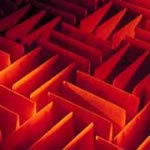Chapter One: An Acoustics Primer

4. What are the characteristics of sound waves? | Page 2
What is Simple Harmonic Motion (SHM)?
Simple harmonic motion (SHM) is a type of periodic motion characterized by a restorative force equal to and opposite the source of displacement—fortunately for us, the surrounding atmosphere provides that force for sound waves, returning them to the ambient pressure when the source of displacement is at rest. Demonstrations of simple harmonic motion are approximated by the motion of a small-angle pendulum or a mass–spring example, both of which are shown in the videos below. The periodic movements of both are represented as tracing a sine wave in the time domain, which takes the shape of its mathematical namesake, the sine function. A sinusoidal wave (including cosine) is the only waveform that produces a single frequency, as can be seen in the Waveform chapter. Any minute deviation from a pure sine produces additional frequencies.
Low-angle Pendulum SHM
Mass–Spring SHM
Simple harmonic motion has a single resonant frequency
In the case of the pendulum example above, the resonant frequency can be calculated as  .
In the case of the mass–spring example above, it can be calculated as
.
In the case of the mass–spring example above, it can be calculated as  .
.
Later in this text, it will be shown that cavity resonators–like a pop bottle–work much like the mass–spring system to produce a single resonant frequency. In fact, the term acoustic mass is often applied to these resonators.